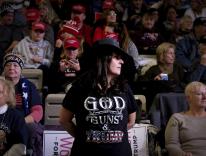The months following last fall’s synodal assembly might have been quietly taken up with preparation for next fall’s if not for the release of Fiducia supplicans on December 18 and the “clarifications” that the Vatican Dicastery for the Doctrine of the Faith issued on January 4. But this is where the Church is. The publication on the “possibility of blessing couples in irregular situations and same-sex couples” and the reactions to it send yet more signals about Francis’s pontificate—but also about the role of the Curia and, indeed, the prospects of the Synod.
Francis’s reform of the Curia, approved in March 2022, was supposed to reshape the dicasteries, making them more collaborative and receptive to the global Church. But Fiducia supplicans raises questions about that. It doesn’t seem that other dicasteries were brought into the process; the declaration, signed by the prefect, Cardinal Víctor Manuel Fernández, and the secretary for the doctrinal section, Msgr. Armando Matteo, simply says that the Dicastery for the Doctrine of the Faith “consulted experts, undertook a careful drafting process, and discussed the text in the Congresso of the Doctrinal Section of the Dicastery.” The subtitle of the declaration is “On the Pastoral Meaning of Blessings.” Fiducia supplicans is purportedly less about doctrine than about the liturgical life of the Church and pastoral care. One dicastery directly affected by the declaration is therefore the one for the liturgy for the definition of blessing. But the dicasteries for the bishops and the clergy also have some competency regarding a document aimed more at those who are in pastoral ministry—bishops, presbyters, and deacons—than at same-sex couples or others who are in “irregular situations.” Working with these parties might have helped in anticipating the negative reaction to Fiducia supplicans from the so-called “peripheries.” It is better to have things in order beforehand than to do damage control later.
Further, if the most important mission of the Church is to evangelize, then the first dicastery should be the one for evangelization. Indeed, that’s just what the 2022 reform of the Curia laid out. The pope himself is the prefect of that dicastery, which consists of two sections each with its own pro-prefect. Yet as of now, the former Holy Office still seems to be number one in the Curia, and the advertised “primacy of place” for the Dicastery for Evangelization seems instead to be an extension of papal primacy, reflecting the way in which Francis governs his Curia. Apart from lack of consultation with other dicasteries, it’s also not clear what (if any) communication there was with the Council of Cardinals, which meets several times a year and at its latest meeting has addressed one of the key synodal issues, the role of women.
As to Fiducia supplicans and the Synod: the fundamental question is whether and how Fiducia supplicans and its reception affect the possibility of consensus on sensitive issues at the second assembly in October. Maybe Fiducia supplicans is Francis’s way of telling us that only the pope, not the Synod, is in charge, or that only the pope is able to take steps when there is lack of consensus on the most sensitive issues.
The agenda of the synodal assembly is ultimately under papal and Vatican control, as specified in the December 11, 2023, statement of the Synod’s office in Rome concerning “matters of great importance, some of which need to be considered at the level of the whole Church and in collaboration with the Dicasteries of the Roman Curia.” These would include changes in canon law, the formation of ordained ministers, the relationships between bishops and religious orders, and theological and pastoral research on the diaconate. The statement by the Synod’s office was more detailed on that last point: “[M]ore specifically, on women’s admission to the diaconate, etc. A list of these topics will be submitted to the Holy Father as the fruit of the Synod Assembly. Groups of experts from all continents together with the relevant Dicasteries of the Roman Curia and coordinated by the General Secretariat of the Synod will be asked to work in a synodal way on the topics indicated by the Holy Father.”
But papal control can also protect and help the Synod. Fiducia supplicans does not mark the first time that a papal or Vatican document has intervened in a synodal or conciliar agenda. In the three intersessions between the four different sessions of Vatican II, there was Pope John XXIII’s Pacem in Terris of April 1963 and Paul VI’s Ecclesia Suam of August 1964, which significantly helped the work of the council. The difference here is that it is still not clear just what the agenda for the intersession is, beyond another round of listening sessions in the spring (as indicated in the guidance in that December 11 communication), or what kind of theological work theologians are supposed to do for the preparation of the second assembly. The plan seems to take into account realistically, and rely on, the different degrees of synodal energy in the Church and the local episcopates, where Latin America and CELAM are the model, while the situation is different in other continents and regions.
But the reactions to Fiducia supplicans are also bound to affect the Synod and its reception. Much has been made of the negative or unenthusiastic responses from many countries in Africa (Angola, Benin, Burkina Faso and Niger, Burundi, Cameroon, Democratic Republic of Congo, Gabon, Ghana, Ivory Coast, Malawi, Mozambique, Nigeria, Rwanda, Togo, Zambia, and Zimbabwe), but that’s only part of the story. Generally speaking, Western Europe has reacted with more enthusiasm than Eastern Europe, but there are shades of difference even between countries in Western Europe (the welcome response from German bishops and the almost total silence of Italian bishops), as well as within individual countries, like the United States and France.
As to what Fiducia supplicans tells us about Francis’s papacy: it’s important because it reflects his will to cement his legacy in a strategic and definitional way—that is, beyond simply appointing bishops and cardinals. Víctor Manuel Fernández is his creature. He is not part of that dicastery prefect’s line of succession inaugurated when John Paul II appointed Cardinal Joseph Ratzinger to the position in 1981. Fernández’s appointment signifies the access of a “commoner” (a pastoral theologian from Argentina) after a line of “blue-blood” systematic theologians from Europe and North America, Roman insiders with personal ties to Ratzinger and the academic world he came from. But there is also a literal change of pace: after Ratzinger’s long tenure, his successors (Cardinals Levada, Muller, and Ladaria) conducted the work of the dicastery by slowing down its doctrinal “legislation.” The age of Ratzinger restored the doctrinal order that had been upset in the post–Vatican II period, and after that there was no longer any need for an activist dicastery for the doctrine of the faith. Judging by the last few months, with a series of responses to dubia and the declarations on blessings, this could be the beginning of a new phase of activism, for a different kind of order (despite the reassurances that Fiducia supplicans doesn’t change doctrine) shaped by the former Holy Office now under Cardinal Fernandez.
Fiducia supplicans isn’t just the first major test for Fernandez. It will also be a test of the unusual mission statement that Francis gave to the former Holy Office in his letter to the new prefect on July 1, 2023. In that letter to Fernandez, the pope seemed intent on closing an almost five-hundred-year-long Tridentine era in the history of the doctrinal office and opening a new one. “As the new prefect of the Dicastery for the Doctrine of the Faith, I entrust to you a task that I consider very valuable,” Francis wrote. “Its central purpose is to guard the teaching that flows from the faith in order to ‘to give reasons for our hope, but not as an enemy who critiques and condemns.’ The Dicastery over which you will preside in other times came to use immoral methods. Those were times when, rather than promoting theological knowledge, possible doctrinal errors were pursued. What I expect from you is certainly something very different.”
The turbulent reactions of individual bishops and bishops’ conferences to Fiducia supplicans marks a first in the modern history of that dicastery. And it suggests that the transition from a Tridentine-era Roman office to a more global and pastoral way of promoting doctrine will be a long and complicated process.
Please email comments to [email protected] and join the conversation on our Facebook page.
Share
Previous Story
Remembering Charles R. Morris
Next Story
The Poet Laureate of Losers

